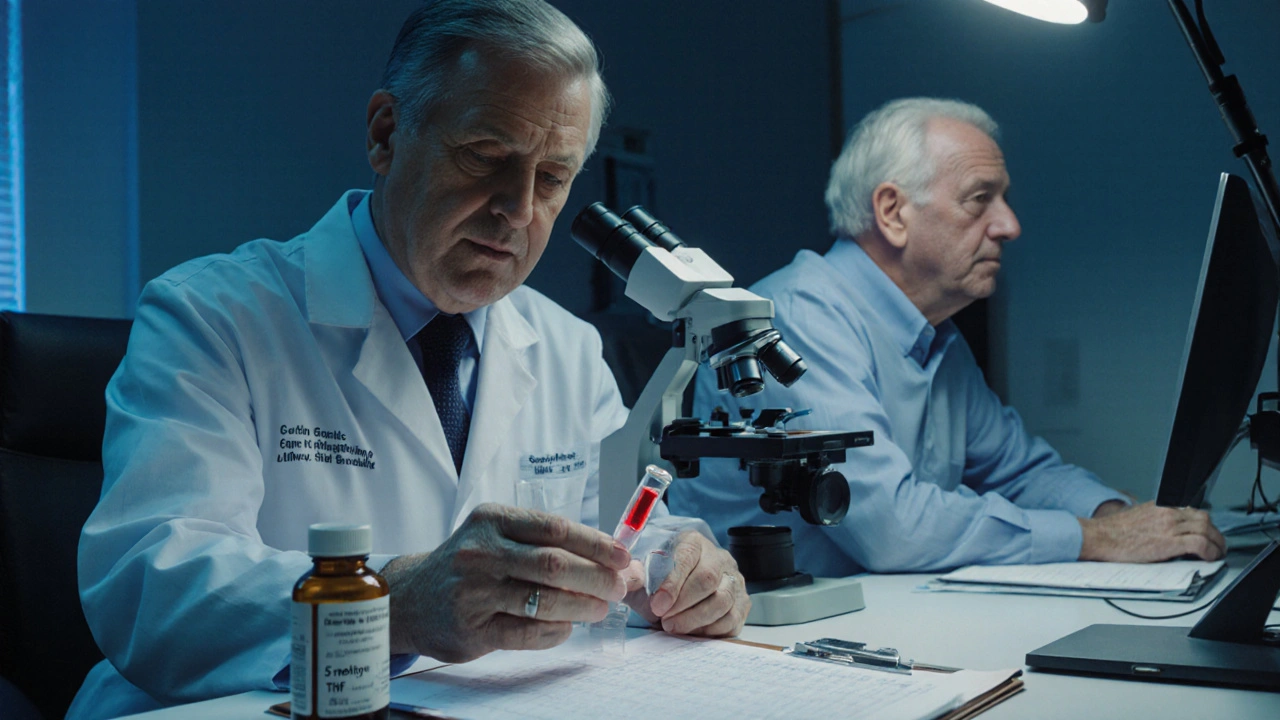How to Spot and Treat Folate Deficiency in Seniors
 Oct, 12 2025
Oct, 12 2025
Folate Deficiency Risk Assessment
This tool helps you assess your risk of folate deficiency based on common symptoms, diet, and medications. Folate deficiency is common in seniors due to reduced absorption, medication interactions, and dietary gaps. A low risk doesn't eliminate the need for proper medical evaluation.
Symptoms
Select symptoms you're experiencing
Diet
How often do you consume folate-rich foods?
Medications
Are you taking any medications that may interact with folate?
Additional Factors
Are you over 65 or have any chronic conditions?
Key Takeaways
- Folate deficiency is common in people over 65 because of reduced absorption, medication interactions, and dietary gaps.
- Typical signs include fatigue, macro‑cytic anemia, and cognitive changes that can mimic dementia.
- Diagnosis relies on serum folate, red‑blood‑cell folate, and homocysteine levels.
- Treatment mixes dietary changes, folic‑acid supplements, and addressing underlying drug‑nutrient interactions.
- Regular monitoring prevents recurrence and supports overall health in seniors.
When it comes to aging, folate deficiency is a lack of the B‑vitamin folate (vitaminB9) in the body, which can disrupt DNA synthesis and red blood cell formation. If you’re caring for an older adult, catching this problem early can mean the difference between a simple vitamin fix and a serious health setback.
Understanding Folate Deficiency
Folates are naturally occurring forms of vitaminB9 found in leafy greens, legumes, and fortified grains. The synthetic form, folic‑acid, is used in most supplements and fortified foods because it’s more stable.
Physiologically, folate works with homocysteine an amino acid that, when built up, can damage blood vessels and increase heart‑disease risk to regenerate methionine, a building block for proteins. When folate levels drop, homocysteine rises, which is a red flag for clinicians.
Why Seniors Are at Higher Risk
People over 65 face several hurdles that make folate deficiency more likely:
- Decreased stomach acid-acid helps release folate from foods; lower acid means less absorption.
- Common medications such as proton‑pump inhibitors, metformin, and certain anticonvulsants can bind folate or alter gut flora.
- Reduced appetite or reliance on processed meals that lack natural folate sources.
- Chronic conditions like chronic kidney disease impair the conversion of folate to its active form.
In addition, genetic factors like the MTHFR mutation a common variant that reduces the body’s ability to convert folic‑acid to its active form can compound the problem, especially in older adults who already have slower metabolism.

Spotting the Signs
Folate deficiency doesn’t always announce itself with dramatic symptoms. Look for these subtle clues:
- Persistent fatigue that isn’t explained by other conditions.
- Shortness of breath during routine activities.
- Glossy, sore tongue (glossitis) or a loss of appetite.
- Macro‑cytic anemia-large, immature red blood cells detected on a CBC.
- Memory lapses, difficulty concentrating, or mood changes that could be mistaken for early dementia.
Because many of these signs overlap with other age‑related issues, a simple blood test is often the most reliable way to confirm folate status.
How Doctors Diagnose
Laboratory evaluation usually follows a tiered approach:
- Serum folate test - measures short‑term folate levels; serum folate test is quick but can fluctuate based on recent meals. Values below 3ng/mL suggest deficiency.
- Red‑blood‑cell (RBC) folate - reflects long‑term stores and is less affected by recent intake.
- Homocysteine - elevated levels (often >15µmol/L) point to folate or B12 deficiency.
- Complete blood count (CBC) - looks for macro‑cytic anemia, indicated by an elevated mean corpuscular volume (MCV) >100fL.
If the CBC shows macro‑cytosis but homocysteine is normal, clinicians may also order a vitaminB12 test to rule out overlapping deficiencies.
Treatment Options
The goal is to restore folate stores, correct anemia, and lower homocysteine. Here’s how most physicians proceed:
- Dietary adjustments - encourage leafy greens (spinach, kale), citrus fruits, beans, and fortified cereals. A daily serving of 1‑2 cups of cooked greens can provide 100‑200µg of folate.
- Oral folic‑acid supplements - for most seniors, 400-800µg per day is enough. Use a folate supplement that contains 5‑methyl‑THF, the bio‑active form, especially if the patient carries an MTHFR variant instead of standard folic‑acid.
- Intravenous or intramuscular folate - reserved for severe cases or when malabsorption prevents oral uptake.
- Medication review - temporarily pause or adjust drugs that interfere with folate, such as metformin or certain anticonvulsants, after consulting the prescribing physician.
- Address co‑existing B12 deficiency - because simultaneous B12 deficiency can mask folate recovery, supplement both if needed.
Most seniors see symptom improvement within 2‑4 weeks of starting therapy, but lab markers may take longer to normalize.

Preventing Future Deficiency
Prevention is easier than cure. Incorporate these habits into daily life:
- Include a serving of fortified grain (e.g., oatmeal) at breakfast.
- Plan weekly meals around a “green” night-stir‑fry, soup, or salad featuring kale, collard greens, or broccoli.
- Check medication lists with pharmacists; ask if a supplement is recommended.
- Schedule a yearly blood test that includes serum folate, especially after changes in diet or medication.
Older adults who maintain a balanced diet and stay on top of routine labs rarely experience severe folate deficiency.
Monitoring and Follow‑Up
After initiating treatment, doctors typically re‑check labs in 8‑12 weeks:
- Serum folate should rise above 6ng/mL.
- RBC folate should approach the normal range (200‑600ng/mL).
- Homocysteine should drop below 12µmol/L.
- Repeat CBC to confirm that MCV returns to 80‑100fL.
If levels plateau, consider switching to the 5‑methyl‑THF form or evaluating for hidden malabsorption conditions like celiac disease. Ongoing monitoring every 6‑12 months keeps the deficiency from resurfacing.
Folate Deficiency vs. VitaminB12 Deficiency in Older Adults
| Aspect | Folate Deficiency | VitaminB12 Deficiency |
|---|---|---|
| Primary cause | Low intake, malabsorption, medication interaction | Intrinsic factor loss, pernicious anemia, gut bacteria changes |
| Lab marker | Low serum/RBC folate, high homocysteine | Low serum B12, high methylmalonic acid (MMA) |
| Typical anemia | Macro‑cytic, hypersegmented neutrophils | Macro‑cytic, often with neurological signs |
| Neurological symptoms | Rare, usually due to severe homocysteine elevation | Peripheral neuropathy, memory loss, gait disturbances |
| Treatment | Folate supplements (400‑800µg daily) + diet | B12 injections or high‑dose oral B12 |
Understanding these nuances helps clinicians choose the right test and avoid mis‑treatment. For seniors, a combined folate‑B12 panel is often the safest first step.
Frequently Asked Questions
How much folate does an older adult need each day?
The Recommended Dietary Allowance for adults 65+ is 400µg of dietary folate equivalents (DFE). Most seniors meet this goal through a mix of food and a daily supplement of 400-800µg.
Can folate deficiency cause memory problems?
Yes, elevated homocysteine from low folate can impair blood flow to the brain, leading to mild cognitive decline. Treating the deficiency often improves focus and short‑term memory.
Is it safe to take high‑dose folic‑acid with a MTHFR mutation?
People with the common C677T variant may not convert folic‑acid efficiently. Using 5‑methyl‑THF (the active form) at standard doses is safer and more effective.
What foods are richest in natural folate?
Spinach (≈194µg per cup cooked), lentils (≈180µg per half‑cup), asparagus (≈134µg per 5 spears), and fortified cereals (≈140‑400µg per serving) are top sources.
How often should seniors get their folate levels checked?
At least once a year, or sooner after changing medications, diet, or if symptoms of anemia appear.
Being proactive about folate deficiency seniors can keep energy levels steady, protect brain health, and avoid unnecessary hospital visits. With the right tests, a balanced plate, and a simple supplement regimen, most older adults can stay on top of their folate needs for years to come.
George Kata
October 12, 2025 AT 04:32Got to say, the article does a solid job laying out why seniors are prone to folate issues. I’ve seen a lot of older patients on PPIs not even realize it could be messing with their B‑vitamins. It’s worth flagging any meds that touch gut acid when you’re doing a check‑up. Also, a quick glance at the diet section can spark ideas for simple swaps like sneaking spinach into soups. All in all, a handy reminder for caregivers and docs alike.
Nick Moore
October 17, 2025 AT 04:32Nice rundown! It’s never too late to bump up those green veggies.
Jeffery Reynolds
October 22, 2025 AT 04:32The piece correctly notes that serum folate can fluctuate with recent meals, which many overlook. It also rightly distinguishes between serum and RBC folate, a nuance often omitted in lay articles. While the recommendations are sound, a brief mention of potential folate‑folic‑acid conversion issues in the MTHFR population would have strengthened the discussion. Grammatically, the text maintains proper structure, though occasional commas could be placed more strategically for readability. Overall, the article meets a high factual standard.
Mitali Haldankar
October 27, 2025 AT 03:32Interesting take, but I think the risk is overblown 🤔. Many seniors get enough folate from fortified cereals without even trying.
snigdha rani
November 1, 2025 AT 03:32Sure, because a single cup of lentils totally fixes everything.
Mike Privert
November 6, 2025 AT 03:32For anyone feeling the fatigue thing, start with a basic food log for a week. Note how many servings of leafy greens, beans, or fortified grains you actually eat. If you’re consistently below the recommended 400 µg DFE, a modest supplement can bridge the gap while you adjust your meals. And don’t forget to mention any PPIs or metformin to your doctor – they might suggest a timing tweak.
Veronica Lucia
November 11, 2025 AT 03:32One could argue that the subtle cognitive shifts described are more reflective of a broader age‑related decline rather than isolated folate deficiency. Yet, the biochemical link via homocysteine is compelling enough to merit routine screening.
Sriram Musk
November 16, 2025 AT 03:32The article’s structure-symptoms, diet, meds, additional factors-is user‑friendly. Including a quick “Assess My Risk” tool encourages proactive health management, which is commendable.
allison hill
November 21, 2025 AT 03:32Sounds like the pharma industry wants us to stay dependent on cheap pills while they hide the real cure in leafy greens. Just saying.
Tushar Agarwal
November 26, 2025 AT 03:32Great overview! 😊 Keep an eye on those meds and maybe add a weekly green‑smoothie to the routine.
Richard Leonhardt
December 1, 2025 AT 03:32Regarding the point about serum folate fluctuations, it’s worth noting that a single low reading doesn’t necessarily indicate chronic deficiency. A follow‑up test after a few days of a balanced diet can provide a clearer picture. Also, the suggestion to use 5‑methyl‑THF for those with MTHFR variants is spot‑on, though many patients aren’t even screened for that mutation. Finally, emphasizing that supplements should be taken with food to improve absorption would be a useful addition.
Shaun Brown
December 6, 2025 AT 03:32While the article tries to be helpful, it glosses over the serious risk of ignoring underlying malabsorption disorders. A more critical view would highlight that merely adding a supplement without addressing gut health can be a waste of resources. Moreover, the tone feels overly optimistic, ignoring that some seniors may never achieve adequate folate levels due to chronic conditions. The piece could benefit from a harsher examination of why many older patients remain under‑treated despite clear guidelines.
Damon Dewey
December 11, 2025 AT 03:32Only supplement if you’re actually deficient.